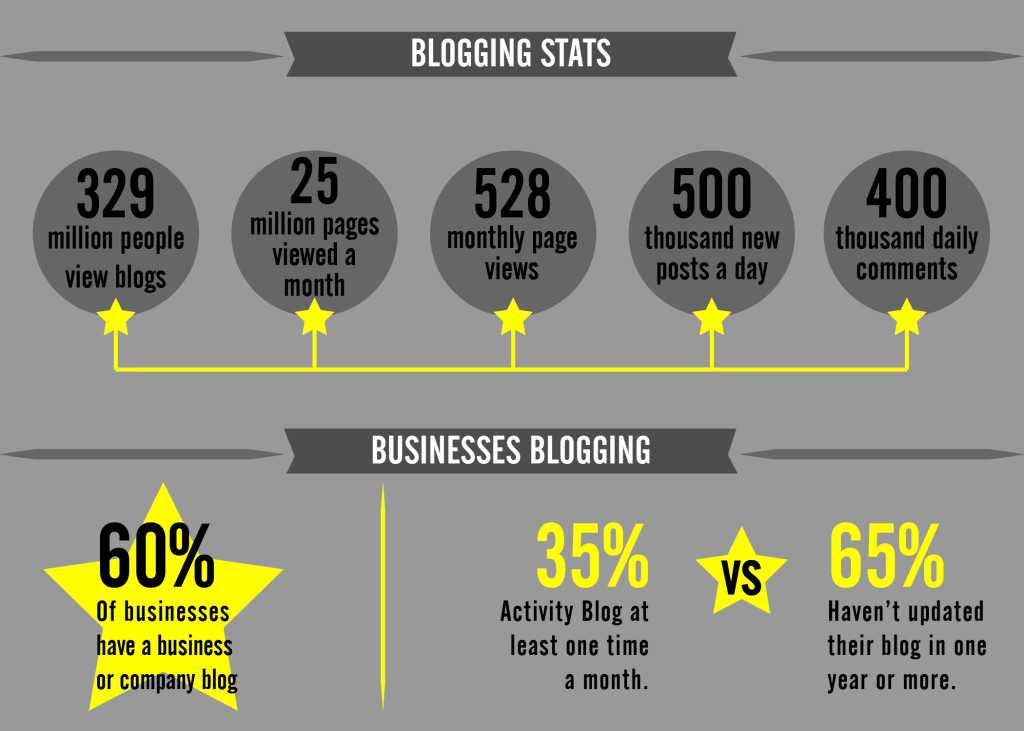
Search Engine Optimization is an interesting field. Certain elements are ever-changing — and yet, there are many methods that remain tested, tried and true throughout the decades. Of course it’s one thing to simply say “WRITE GOOD CONTENT” and quite another to actually implement that advice. A couple weeks back we offered 8 tips to starting a blog. In this post, we’ll try to give you some more specifics on what makes a quality blog post these days. If you’re still not 100% clear on it, then contact us about hiring one of our experienced SEO copywriters.

How can you differentiate your blog from all the other posts out there? Image Source: TransformationMarketing.com
1. Write witty headlines geared toward people.
In Olden Times, we believed that packing headlines with keywords was the top priority in attracting search engine attention. As a result, the internet ended up with horrible headlines like “How to Generate Leads With Facebook, Run Facebook Ad Campaigns, and Get More Likes on Facebook.” Instead, you could try a headline that succinctly tells people what value they’ll get from your article — like “Become A Facebook Master: 10 Ways To Generate Leads” or “How To Get More Followers On Facebook.”
2. Aim for quality
Remember high school essay writing? Word and page counts were the biggest scourges to the student’s existence. Perhaps you could stretch that paper out by increasing the font size or adding in more direct quotes. More often than not, you probably wound up repeating yourself and cramming vaguely descriptive phrases in, even if it sounded like total garbage. If you can create an awesome post in 1,500 words, great! But if you find yourself cramming in keywords and repeating yourself several times, stick to a shorter post length. Use vivid visual images, videos and links to outside sources in your articles and only use words with substance.
3. Build links by engaging the community.
By now, we all know that link building is an important SEO strategy. However, there are so-called SEO “gurus” that are still practicing old “black-hat” tactics that can get a website banned from the search engines. You don’t want to publish links to your site on “link farm” websites or in spam comments, for instance. Instead, reach out to complementary blog owners and ask for a link exchange. You can also try guest posting and linking back to your blog.

4. Zero-in on better keywords.
Keyword research is an art in itself, and it’s a reason that many website owners come to us. Commonly, people use keywords that are overly generalized. Finding the best keyword is like naming a new baby. You want something that is unique, but not so unique that your child is ridiculed for a lifetime. Likewise, you don’t want your child to be one of ten kids in his or her class with that name. Your keyword search should be dynamic. Don’t just choose a keyword once and forget about it. Always look at what your market is searching in the current moment.
5. Carefully choose where those keywords go.
Not all keyword locations are created equal. Here are a few spots within your post that weigh in heavier:
- Post titles
- Page titles
- Internal links
- URL shortlink
- Outbound links (be careful though! Branded outbound links are recommended.)
- Bold tags
- H1, H2, H3 heading tags
- Image alt tags
- Meta tags
- The first sentence
- The last sentence
6. Remain current with Google.
If you don’t know what “Panda” or “Penguin” means, then you have probably missed a lot of Google news. Matt Cutts and crew are always changing up the Google algorithm and offering hints on what may improve your ranking. We’ve worked with many people who missed out on a major change and ended up seeing their sites plummet from top rankings to virtual obscurity literally overnight. The good news is that you can often climb right back up with a few calculated tweaks.

7. Create themed websites.
If your interests or product offerings are diverse, then you may want to consider giving up the “one-blog-fits-all” notion. Themed micro-sites are a great way to cross-link and build a reliable audience. Your chance of ranking high for keywords within your industry will increase if you create a themed site, rather than a generalized one.
8. Pay attention to blogs in your industry.
Reading other blogs in your industry is one of the best ways to craft an effective blog calendar for your business. Using tools like BuzzSumo.com can give you a pulse on what blog posts are hot in your industry and which ones have received the most social shares and backlinks. Social media is a HUGE help for crafting SEO-friendly blog posts. Typically the posts that get the most social shares are the posts that rank the best in the search engines like Google.
Would you like it if your blog was your #1 driver of traffic to your website?



Hi Mandy,
Informative post indeed.
For a blogger SEO is the major concern. But as we all know that making human relationships is much better to think about than SEO. If we have good circle then it’s obvious to get traffic to our blog.
Quality content is what we should try to provide at our blog. Google like the blogs which have the content to get shared with readers. People like to read unique content.
Thanks for sharing this post with us.
Have a great day ahead.
~Ravi
I like how you talked about going for quality over quantity. A lot of times I talk to clients who just want to pay as little as possible and don’t understand they are most likely paying for black hat techniques that won’t get them results, or even worse, make them worse!
Thanks for sharing such useful info with us. I have my own blog and was looking for this type of advice. Making eye catchy title and unique content is the key factor. Also Google Authorship can increase your authority graph higher.
HI, Mandy, Thanks for sharing such useful info with us. I have my own blog and was looking for this type of advice.